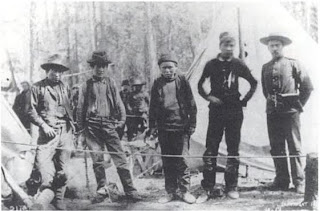
A notorious case that started with a burglary. As Kitty Smith, grand-neice of the Nantuck Brothers put it:
Some Indians stole some baking-powder from a prospector’s camp. Turned out it was arsenic, perhaps put there deliberately, perhaps just supplies for refining gold. In any case, two Indians died.
At that time, customary Indian law dictated that members of victims’ moiety or clan (Crow of the Klinkit Tribe) take steps to avenge the deaths, if not against the individuals actually responsible, at least against representatives of their moiety or clan. The debt could be paid by money or a death.
When asked for payment, purportedly, the prospectors said no. At this point, as related by the 4 Nantuck brothers (Joe, Jim, Dawson and Frank), they shot two white prospectors on May 10 1898. One of these, William Meehan, died, while the other, Christian Fox survived and went to RCMP who subsequently arrested the four native brothers.
RCMP took the boys to Dawson where an extensive trial took place. Although they confessed, Canadian leaders felt the need to be lenient because of past cases and a change in attitude towards the First Nations people. In the end, Frank and Joe died of consumption (TB) in jail during 1898 and the other two, Dawson and Jim were hung in Dawson on August 4, 1899.
from two books: Life Lived like a Story by Kitty Smith et. al. and Essays on the History of Canadian Law by John McLaren and Hamar Foster.









